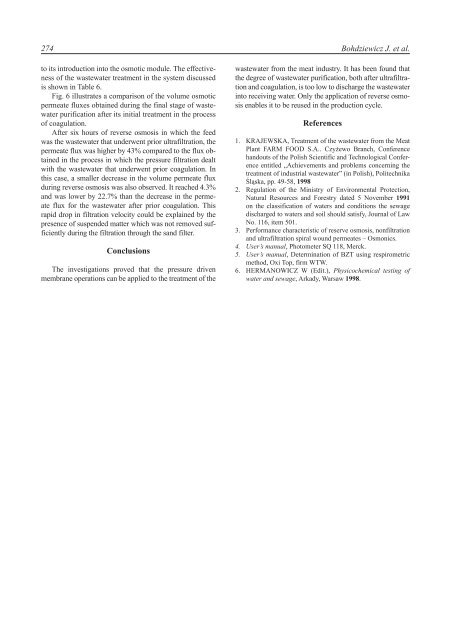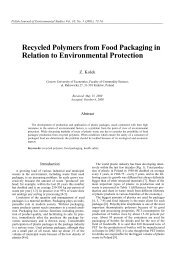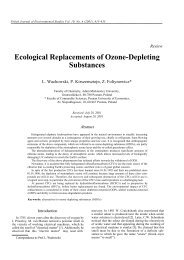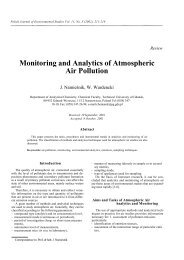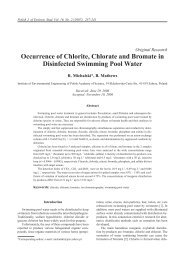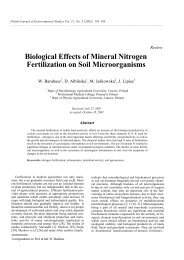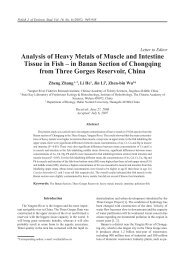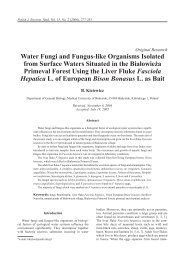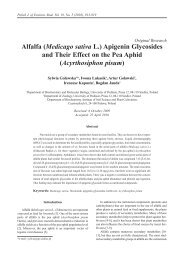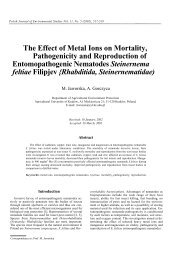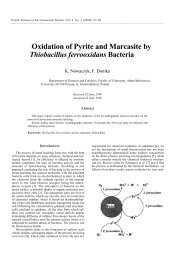Application of Ultrafiltration and Reverse Osmosis - Polish Journal of ...
Application of Ultrafiltration and Reverse Osmosis - Polish Journal of ...
Application of Ultrafiltration and Reverse Osmosis - Polish Journal of ...
You also want an ePaper? Increase the reach of your titles
YUMPU automatically turns print PDFs into web optimized ePapers that Google loves.
274<br />
to its introduction into the osmotic module. The effectiveness<br />
<strong>of</strong> the wastewater treatment in the system discussed<br />
is shown in Table 6.<br />
Fig. 6 illustrates a comparison <strong>of</strong> the volume osmotic<br />
permeate fluxes obtained during the final stage <strong>of</strong> wastewater<br />
purification after its initial treatment in the process<br />
<strong>of</strong> coagulation.<br />
After six hours <strong>of</strong> reverse osmosis in which the feed<br />
was the wastewater that underwent prior ultrafiltration, the<br />
permeate flux was higher by 43% compared to the flux obtained<br />
in the process in which the pressure filtration dealt<br />
with the wastewater that underwent prior coagulation. In<br />
this case, a smaller decrease in the volume permeate flux<br />
during reverse osmosis was also observed. It reached 4.3%<br />
<strong>and</strong> was lower by 22.7% than the decrease in the permeate<br />
flux for the wastewater after prior coagulation. This<br />
rapid drop in filtration velocity could be explained by the<br />
presence <strong>of</strong> suspended matter which was not removed sufficiently<br />
during the filtration through the s<strong>and</strong> filter.<br />
Conclusions<br />
The investigations proved that the pressure driven<br />
membrane operations can be applied to the treatment <strong>of</strong> the<br />
Bohdziewicz J. et al.<br />
wastewater from the meat industry. It has been found that<br />
the degree <strong>of</strong> wastewater purification, both after ultrafiltration<br />
<strong>and</strong> coagulation, is too low to discharge the wastewater<br />
into receiving water. Only the application <strong>of</strong> reverse osmosis<br />
enables it to be reused in the production cycle.<br />
References<br />
1. KRAJEWSKA, Treatment <strong>of</strong> the wastewater from the Meat<br />
Plant FARM FOOD S.A.. Czyżewo Branch, Conference<br />
h<strong>and</strong>outs <strong>of</strong> the <strong>Polish</strong> Scientific <strong>and</strong> Technological Conference<br />
entitled „Achievements <strong>and</strong> problems concerning the<br />
treatment <strong>of</strong> industrial wastewater” (in <strong>Polish</strong>), Politechnika<br />
Śląska, pp. 49-58, 1998<br />
2. Regulation <strong>of</strong> the Ministry <strong>of</strong> Environmental Protection,<br />
Natural Resources <strong>and</strong> Forestry dated 5 November 1991<br />
on the classification <strong>of</strong> waters <strong>and</strong> conditions the sewage<br />
discharged to waters <strong>and</strong> soil should satisfy, <strong>Journal</strong> <strong>of</strong> Law<br />
No. 116, item 501.<br />
3. Performance characteristic <strong>of</strong> reserve osmosis, nonfiltration<br />
<strong>and</strong> ultrafiltration spiral wound permeates – Osmonics.<br />
4. User’s manual, Photometer SQ 118, Merck.<br />
5. User’s manual, Determination <strong>of</strong> BZT using respirometric<br />
method, Oxi Top, firm WTW.<br />
6. HERMANOWICZ W (Edit.), Physicochemical testing <strong>of</strong><br />
water <strong>and</strong> sewage, Arkady, Warsaw 1998.


